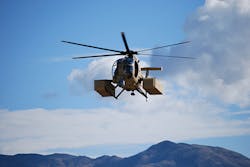Aurora moves forward with project to develop unmanned helicopter for battlefield resupply
ARLINGTON, Va. - U.S. Navy experts are moving forward with a project to develop an unmanned helicopter for delivering and picking up cargo and equipment under fire on forward-edges of the battlefield.
Officials of the Office of Naval Research (ONR) in Arlington, Va., announced an $11.2 million contract modification to Aurora Flight Sciences in Manassas, Va., to support flight testing for the Autonomous Aerial Cargo I Utility System (AACUS) program. The AACUS project is developing prototype unmanned vertical take-off and landing (VTOL) aircraft to demonstrate advanced autonomous capabilities for battlefield resupply and retreat. Eventually, Navy researchers want to use unmanned helicopters to evacuate battlefield casualties.
Key features of AACUS include an unmanned aerial vehicle (UAV) able to avoid obstacles autonomously while finding and landing unprepared landing sites on the battlefield with control by a field operator with no special training. This contract is for flight testing that will support the overall goal of the AACUS program, which is advance the state of the art in rotorcraft autonomy for response cargo delivery to widely separated small units in demanding and unpredictable conditions that pose unacceptable risks to ground resupply personnel and aircrews.
At this stage of the program, Aurora Sciences experts are focusing on advanced perception systems, supervisory control interfaces, and real-time level mission management.
AACUS expands the capability of VTOL aircraft across a range of man-ned and unmanned aircraft. This program will deliver a sensor package and software suite that enable unmanned helicopters to take off, navigate, approach, and land at unprepared landing site autonomously.
Aurora Flight Sciences experts will focus on field user devices that help fly one or more autonomous helicopters; sensors and algorithms for obstacle detection and landing zone evaluation - particularly in fog, dust, smoke, or other degraded visual conditions; and mission planning algorithms and user interfaces to support assault missions.
Aurora Flight Sciences has been demonstrating AACUS technologies using the company's Tactical Autonomous Aerial Logistics System (TALOS) on a version of the Boeing optionally manned MH-6 Little Bird light helicopter, which can fly manned or unmanned.
Lockheed Martin Corp. also has been involved in the first phase of the AACUS program. Lockheed Martin used the Open-Architecture Planning and Trajectory Intelligence for Managing Unmanned Systems (OPTIMUS) sensor and software package on the Kaman K-Max helicopter.
Aurora Flight Sciences and Lockheed Martin conducted flight dem- onstrations of their AACUS technologies in February and March 2014 at Quantico Marine Base, Va. Aurora flight Sciences won a contract in April 2014 for the second phase of the AACUS program, which focuses on capability expansion and technology maturation on the same aircraft.
The AACUS program is taking an open-architecture approach for global management of mission planning data, and is developing technologies that are platform-agnostic and transferable to new and legacy unmanned cargo aircraft.
AACUS-enabled unmanned aircraft are to fly in all weather conditions, be launched from sea and land, fly in high and hot environments, and autonomously detect and negotiate precision landing sites in potentially hostile settings.
On this contract modification, Aurora Flight Sciences will do the work in Manassas, Va., and should be finished by February 2017.
FOR MORE INFORMATION visit Aurora Flight Sciences online at www.aurora.aero, or the Office of Naval Research at www.onr.navy.mil.

